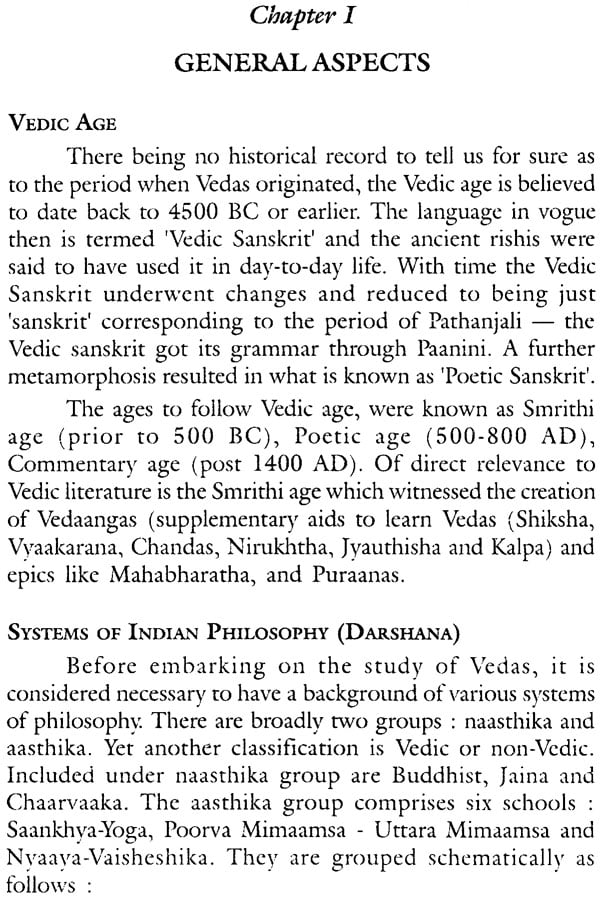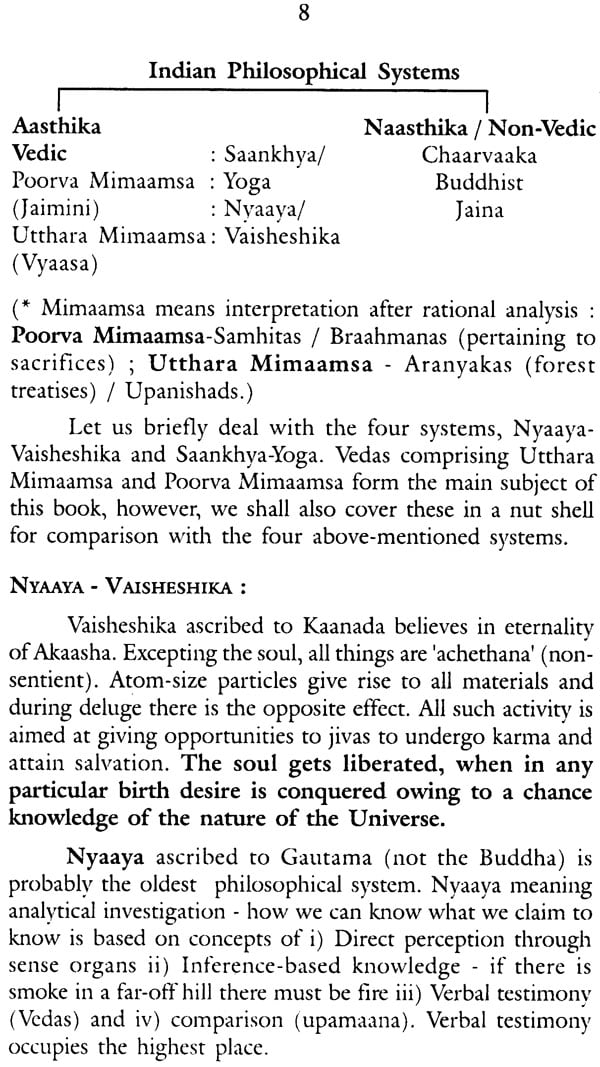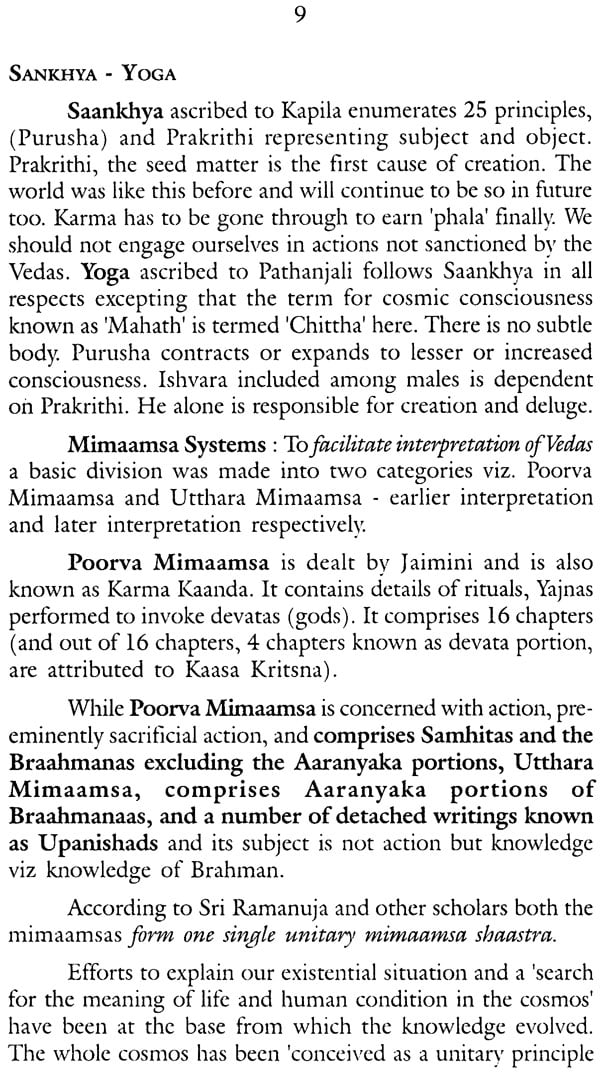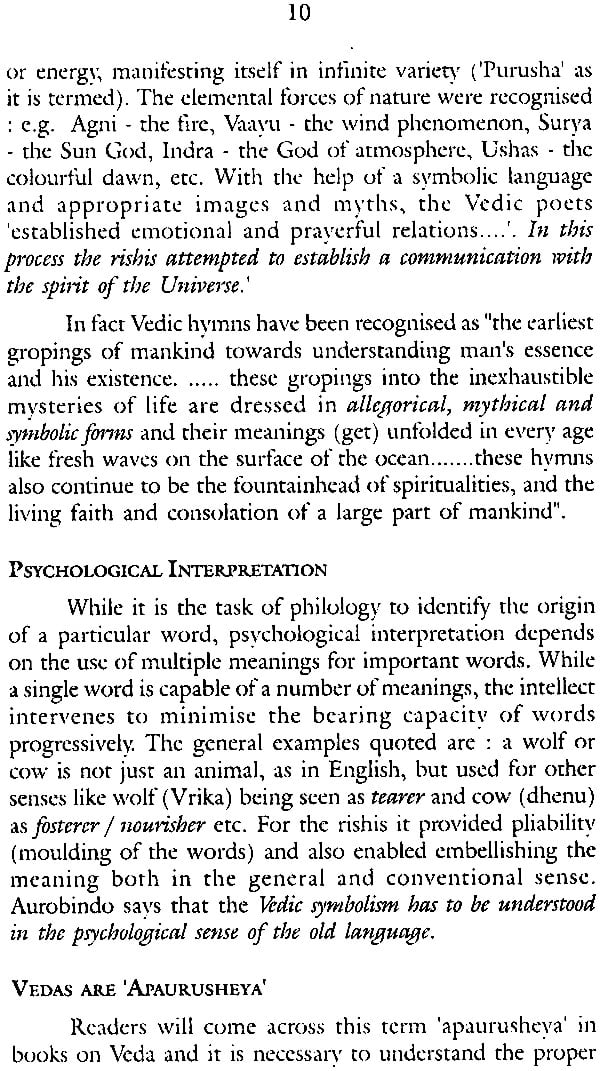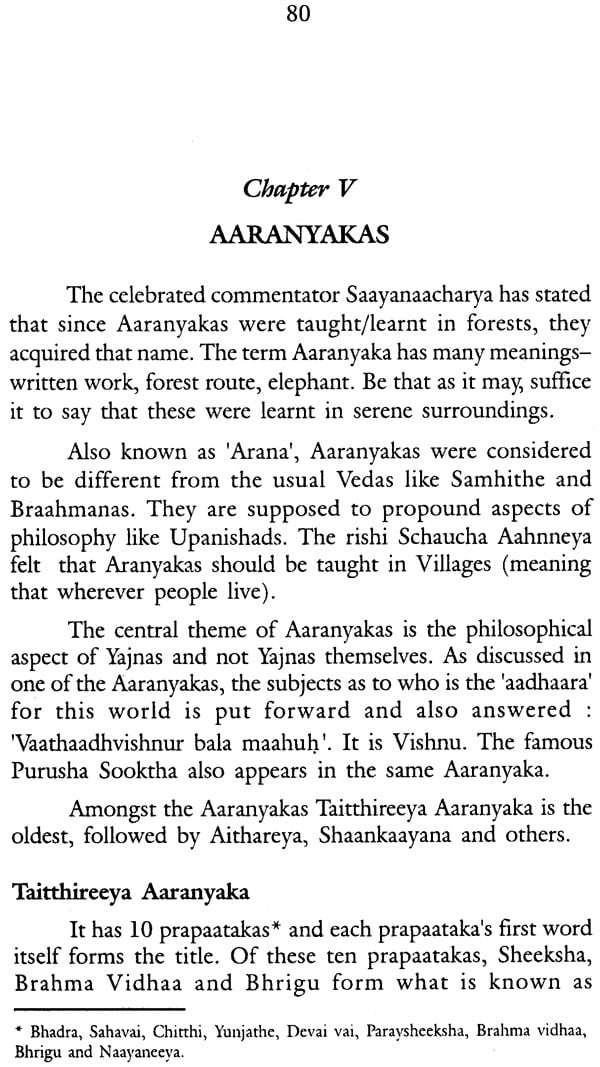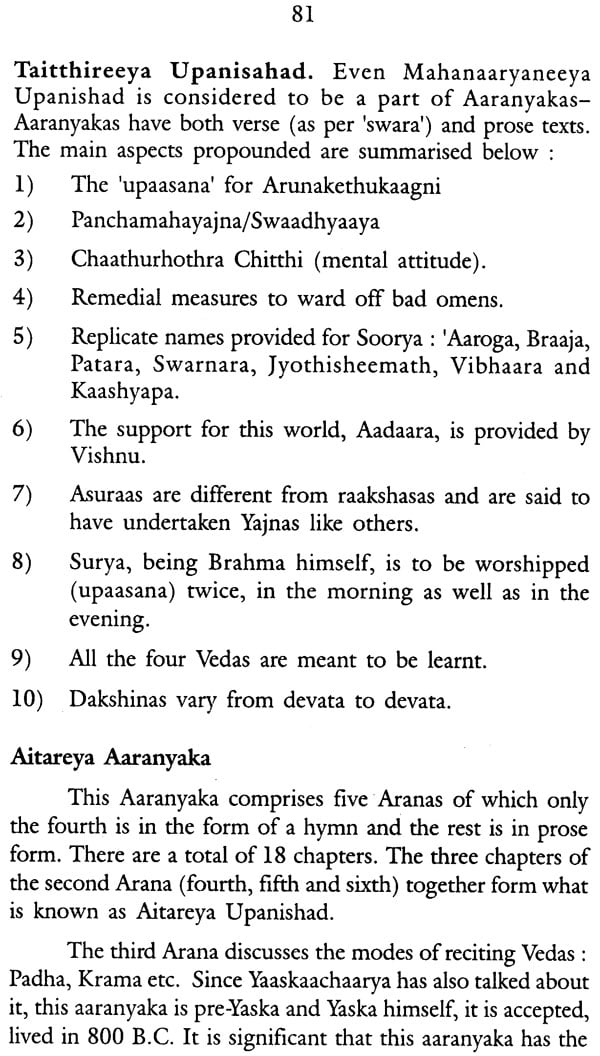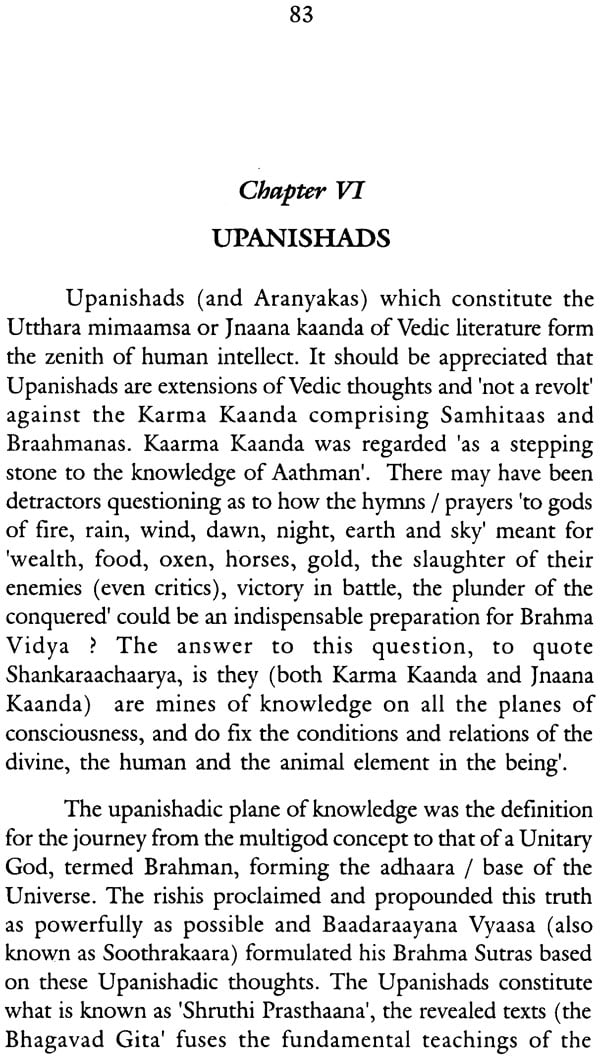
The Veda (Our Heritage)
Book Specification
| Item Code: | NAM803 |
| Author: | K. R. Krishnaswami |
| Publisher: | A & K PRAKASHANA |
| Language: | English |
| Edition: | 2004 |
| Pages: | 140 |
| Cover: | Paperback |
| Other Details | 8.5 inch X 5.5 inch |
| Weight | 170 gm |
Book Description
The mention of the very word "VEDA" conjures up in the mind of an ordinary person the picture of an orthodox purohit (priest) chanting mantras considered extremely holy. Prodding him further might find him saying that such mantras are recited during marriages or yajnas ; it is possible that he had read in newspapers that special Vedic mantras were recited expressly to invoke the rain gods! So far so good, since all these statements are correct. But should you. query him further on the Vedic origin/age, classifications, likely Aryan connection, Vedic symbols / images / gods, commentators etc., you are likely to draw a blank. It is the main purpose of this treatise to address to this gap in knowledge in a concise, yet in an all-embracing manner, and to use a topical term, 'showcase' the most glorious dawn in the ancient history of human existence !
Veda, far from being dubbed as a 'priest-craft', means 'knowledge'; knowledge both within and from beyond our sense perception ..... Vedas are regarded as a system of higher understanding.... to explain one's present situation; to enable people 'to know who they are, how they got here, how this world works and how to use this life for the best advantage .... '
It is rather regrettable that the teachers of Vedas know very little about the lofty messages contained in the hymns they teach. But one must hasten to admire and recognise the fact that this system of oral transmission of Vedas from one mouth to another down the ages, particularly when there was no script available to document the texts, has stood the test of time; an amazing feat and practice that has enabled keeping intact the Vedas in the purest and serene form as we see them to-day.
It should also be appreciated that the rishis or Vedic poets did not intend to lay bare the 'inner soul of the meaning' of hymns to the uninitiated or unfit who might find them as unconnected sentences 'and remote for grasping'. In short it indicates the existence of a 'woven mask' of hidden truths/ spiritual formulae / esoteric symbols.
'Vedic literature' does not just stand for the four groups of Vedas one has commonly heard about but for the entire corpus comprising, besides Vedas, the epics (like Mahabharatha), Bhagavadgita, Paancharaathra Aagarna, Puraanas, Brahma Soothras.
As the subject of Vedas is rather difficult to comprehend in a one-off step, I have chosen to introduce the subject briefly in the first stage followed by an expansion of that introduction and finally covering the sub-topics of each title with broad details.
The Golden Dawn
The people of the sub-Himaalayan region must have had a 'charmed life' for quite a few millenniums, as their habitat was witness to probably the most glorious dawn in the history of mankind and home to ennobling 'human experience in the ancient world'. It is immaterial whether they were Dravidians or Aryans or Dravido-Aryans since the symbolic visions and profound speculations of Vedic poets there on 'life here and hereafter' have engaged the attention of succeeding ages and it is amazing that 'time has not dimmed that vision or dampened the enthusiasm'.
The Oldest And Richest Heritage
Long before civilizations took root in other countries, our rishis had discovered a noble life and their thought processes stand witness to their conception of such a life - their lofty thoughts had provided goals for the life of people at large. Their holy statements in the short 'surra-style' are considered a rich treasure, the rarest heritage of an ancient civilization.
History shows that western scholars were hard put to believe that Vedic civilization was far more ancient than the Greek civilization. Indian scholars who were certain about this fact tried to prove with authentic details that the former indeed preceded the latter by a wide margin. Prominent amongst them were Dr. Bhandaarkar, Baala Gangadhara Tilak.
Western Scholars - Our Vedic Literature
It should however be admitted that the Western scholars displayed a unique and enormous interest in our Vedic literature. In fact their work came in handy to our scholars particularly at a time when they had not yet attempted original work at either the historical or interpretive planes. The enormous work done by some great western scholars like Max Muller and others is mind-boggling, to say the least, and puts most of us to shame, particularly when we remember that not many of our own countrymen evince even the minimum interest in our own heritage.
Vedic Gods Opposite Greek Gods
While we have long accepted the role of gods like Indra, Agni, Vaayu etc. as governing our lives, it is interesting to see how a Westerner views our beliefs : 'Indian orthodox philosophy arose from the ancient Aryan religion of Veda ..... The features of human birth, growth and death, and of the process of generation were projected in the course of nature. Cosmic forces and phenomena were personalized. The lights of the heaven, the varieties of the aspects of clouds and storm, forests, mountain masses and river courses, the properties of the soil, and the mysteries of the underworld were understood and dealt with in terms of the life and commerce of divine beings who themselves reflected the human world. The gods were supermen endowed with cosmic powers and could be invited as guests to feast on oblations. They were invoked, flattered, propitiated and pleased.'
In sharp contrast, 'the gods (in Greece) became laughable and were regarded as incompatible with more spiritual and ethical, later concept of identity In the Homeric age the human features and biographies of gods were rejected, even satirized.' Gods in India were 'never dethroned', neither they got disintegrated nor dissolved'.
Vedic Origins / Vedic Age / Aryan Connection
A subject which has attracted maximum attention amongst both groups viz Western and Indian scholars pertains to immigration of Aryans into India and their link to Vedas. Going through the huge volume of literature one cannot come to any authentic conclusion. Some scholars zero in on the present Punjab region as being Aryan location where Vedas originated in India and our rishis were the conduits for the divine vision and the Vedic hymns. It does not fall within the purview of the book of this size (desiring to cover all aspects) to get embroiled in this subject.
There have been lots of extrapolations / interpolations in regard to the period when Vedas came into being. While it is generally accepted that Vedas were the earliest literature, their period is slotted into ± 500 years of 4000 BC. Some Western scholars, thinking differently, place it around 1200 BC (Max Muller) ; some others at 2400 BC (Haug).
Thus the Vedas, not lending themselves to historical documentation, gave a slip to history itself! There were two main reasons for this ; first, the Vedas were far too many in number with long periods separating one another and secondly, the rishis, the Vedic poets, chose to remain in the background resulting in a total absence of biographical details.
"Expired" By God
The most famous phrase is that although rishis are mentioned 'as bringing the Vedas to us', the Vedas are said to have been 'expired' by God Himself and that the rishis, so to say, were not 'inspired' to bring them. In other words, the enlightened rishis were the media or the conduits chosen by God Himself. The Vedas are thus the very breath of God, self-valid and eternal, infallible and impersonal. According to the Smrithi : "In the beginning there was sent forth by the Creator the eternal word of the Veda (and from it originated all creations).
The Generic Division Of Vedas
A brief classification of Vedas which is commonly known, falls under four headings : Rig, Yajur, Saama and Atharvan.
Each of these Vedas is further divided into:
Type 1 Samhita (a collection of Verses)
Type 2 Braahmanas (prose: details of rituals)
Type 3 Aranyakas (forest - treatises), and
Type 4 The Upanishads (philosophy / Vedanta).
The Vedic Word: Power And Sense
It may be recalled that in the earlier stages the priest was not only a teacher but a seer too, while the latter-day purohits conducted Vedic rites with imperfect knowledge of what 'power and sense' the words they were chanting had. With material aspects of Vedic rituals becoming prominent, 'the power had begun to disappear' from the words being repeated. To add to this situation, the Vedantic movement promising to recover the lost meaning of spiritual experience led to the regrettable stand : 'Veda for the priests, Vedanta for the sages' !
Veda And The Obligatory Duties
As regards the obligatory duties the jet age has not been a deterrent. The Sandhyavandhana, for example based on Veda mantras in praise of gods has remained intact till to- day - the duties and rites performed at birth, death, marriage, yaaga / yajnas abound in Veda mantras. The Vedic tradition thus continues.
The Gods we pray to during Sandhyavandhana include amongst others Agni, Indra, Mitra -Varuna, Brahma, Soorya, Savitr, Vishwedevas, Gayathri-Savithri-Saraswathi- Prithvi devatas. Besides saptharishis we remember Vishwarnirra, Vaamadeva. We shall be getting to know the Vedic Gods in some detail in this treatise.
| Acknowledgements | ||
| Preface | 1 | |
| Introduction | 3 | |
| Contents | ||
| Chapter I : | General Aspects | 7 |
| Vedic Age | ||
| Systems of indian Philosophy | ||
| Symbolisom in Vedas | ||
| Psychological Interpretation | ||
| Vedas as Apaurusheya | ||
| Defining Veda and Vedic Literature | ||
| Translations and Commentaries | ||
| Division of Vedas by Veda Vyaasa | ||
| Vedic Sacrifices | ||
| Preserving the Vedic Treasure | ||
| Vedic mythology and Vedic economy | ||
| Chapter II : | Vedic Gods | 23 |
| Gods of the Earth, Gods in Anthariksha and Gods of Heaven | ||
| Chapter III : | Expanding on the four divisions of Veda | 51 |
| Samhitas ; Brahmanas ; Aaranyakas, Upanishads | ||
| Chapter IV : | Studying Individual Vedas | 56 |
| w.r.t. Samhitas, Braahmanas ; Sacrificial Systems covered in Braahmanas | ||
| Chapter V : | Aaranyakas | 80 |
| Rig Veda Aaranyakas; Saama Veda Aaranyakas and Yajur Veda Aaranyakas. | ||
| Chapter VI : | Upanishads | 83 |
| A. General Aspects : | 84 | |
| A broad definition; Reflections / Reelations ; | ||
| the Eternal message ; | ||
| The number and Age of upanishads ; | ||
| Life during the age of Upanishads; | ||
| Structure of Upanishadhic Texts; | ||
| Classification of Upanishadic Texts ; | ||
| Commentaries on Upanishads ; | ||
| Translations; A sample Mantra. | ||
| B. Dashopanishads : | 91 | |
| A brief study of the ten major Upanishads. | ||
| Chapter VII : | Purusha Sooktha | 127 |
| Chapter VIII : | Vedaangas | 130 |
| References | 133 |
